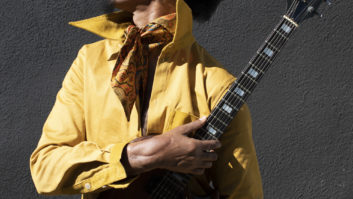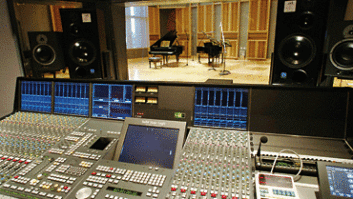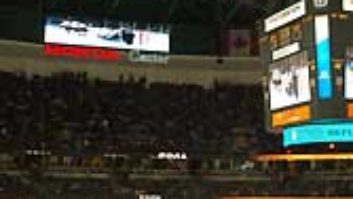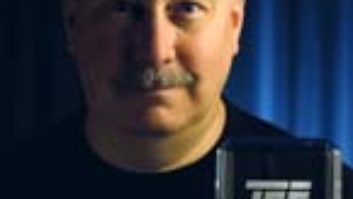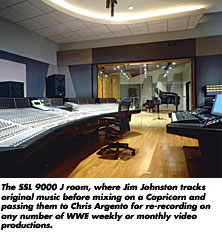
Are they at the Triple Threat Match? Maybe WrestleMania? If you’rein search of the ultimate World Wrestling Entertainment (WWE) tag team,the best place to find them isn’t in the ring, but in a studio inStamford, Conn. That’s where Jim Johnston, WWE director of music, andChris Argento, director of audio post-production, create a powerfullylarge catalog of sound, using an efficient workflow to battle apositively brutal schedule.
Responsible for providing the music and sound effects forapproximately nine original hours of programming and eight to 10 promosa week; three hours of pay-per-view and a home-release DVD per month;video games; and a new full-length CD of complete songs called WOriginals, this duo and their colleagues, including mixer Tim Rocheand audio assistant Darryl Harvey, are a force to be reckoned with.Adding to the stress is the fact that their audio plays out to some ofthe most opinionated audiences anywhere.
“I’m writing music for an entity that people don’t tend to belukewarm on,” notes Johnston. “They tend to really be fans,or they think this is either the most boring or insane thing in theworld. Music is such a wonderful and vital thing that in so many waysmakes our lives go. It’s what makes TV go, and it makes our cars go— just take the CD player out and the driving experience becomesvery different. It’s pervasive in the WWE, because it’s the storylinefor all these characters.”
Everyone in the WWE’s TV production studios starts with the samedirective: “Do good work and do it quickly!” Argento sayswith a laugh. “You get very immersed in what you do here, and thefact that we can turn out the volume of work that we do in a buildingwhere there’s maybe 100 people is pretty fantastic. The whole buildingis like a big machine, a tremendous clock with everybody performing afunction and moving along.”

Getting immersed in the job is easy for Johnston, whose spacious andcalming Russ Berger — designed facility is tailored specificallyfor his needs, and his needs alone. “Russ’ goal was to make thisplace heaven for me, and he was successful,” says Johnston.“I call this the ‘ultimate project studio.’ At itscore, it’s an absolute world-class studio with the most amazingequipment imaginable. The distinction is that other great studios— and I’m not taking anything away from them — are a placeto record in that you rent. You come in with the people or instrumentsyou’ll use, and each time a different set of sounds is coming throughthe door. Here, it’s the best of both worlds, with my collection ofamps, drums and every synth module imaginable — to have it allset up the way you like it is just a wonderful scenario.”
The signals in Johnston’s control room go through an SSL 9000 Jconsole and MOTU Digital Performer 4.1, and are monitored via DynaudioC-4 and AIR 5.1s and Genelec 1031As, among other speaker systems. Hisassortment of outboard gear is expansive and positively slamming,stocked with such units as a Focusrite ISA 430 and four Neve 1073 micpre’s; a Fairchild 670; four LA-2As and four Tube-Tech CL 1Bs fordynamics; two Pultec EQP-1S and DW Fearn VT-4 EQs; a Sony DRE-S777sampling reverb; and microphones from Neumann, Earthworks, Blue andRoyer, among others. Synths include a Korg Triton rack, Roland XV-5080and two Synclavier 6400s. Meanwhile, his adjoining live room is aplayground for instrument collectors, with a wide range of guitars,basses and keyboards, plus multiple recent and vintage amps, all mikedup and ready to go at a moment’s notice.
When Johnston gets an assignment — often on a Monday morningfrom a producer on the road needing a new theme in a few hours —he’s ready to take it on completely by himself. He works happily insolitude without co-writers or an engineer, and plays almost everyinstrument. “The studio was designed according to my incrediblelevel of impatience,” he explains. “The key is easyaccessibility — to jump from a keyboard scenario to a completelive setup, or from recording on hard disk to 24-track tape. It’s awonderful luxury to work in a place where everything is exactly the wayyou want it and doesn’t break the creative flow.”
The seeds for Johnston’s singular method of working were sown at atiny recording lab in college, where he learned how to create completesongs by bouncing tracks first on a 2-track and then on a 4-track.“That teaches you to compose ideas that are concise and get youto where you’re going without 7,000 tracks,” he says. “Forme, 48 tracks is a big project.”
Because Johnston has the creative process down to a science, when arush order for a 30-second entrance theme comes in, he can constantlycome up with new ideas in styles ranging from rock, urban and hip hopto opera. “The most frequent needs are themes for the WWEsuperstars themselves,” says Johnston. “A standard scenariois we get a call from our executive producer: ‘We’ve got anew guy coming,’ or ‘He’s breaking out of a tag team and heneeds music.’ It’s like scoring for a movie: Is he a good guy or a badguy? Is he light and svelte and quick-moving, which dictates a fasttempo, or is he a big plodding kind of a guy, in which case you need abig, heavy, the-wrath-of-God-is-coming-upon-us sound?
“At the end of the day, I think of myself as a scoringcomposer because it’s my responsibility to make sure the audience feelsthe right emotion when any one particular character comes up,”Johnston continues. “So it’s, ‘Here comes Steve Austin!What’s he going to do this time?’ Or with Rey Mysterio, you wanthis Mexican background to come through — it’s part of hischaracter. We did a song where he literally did a rap: It’shalf-Spanish, half-English, with a Mexican infusion into thebeat.”
The tricky part of composing and performing everything on his own isthat Johnston must take care not to repeat himself. “I feel areal sense of responsibility to make sure that each of our superstarshas a unique-sounding piece of music,” he says. “For theaudience, it’s name-that-song in one note. I want them to hear thefirst bar of music and know and feel exactly who’s coming out that doorand immediately be in the mood of that person. One of the greatestchallenges I have is trying to make things sound different. A lot oftimes, I’ll try different amps and different combinations of things,just to get away from what everybody’s expecting.”
Not surprisingly, he expects each piece in the signal path to make asolid contribution to the song. “If I’m going to put something inmy recording chain, I’m choosing it for a sound,” Johnstonstates. “I look at it the way I choose a guitar: If I wantsomething bright, I’ll reach for a Rickenbacker or a Telecaster; for acrunchy sound, I’ll use the Les Paul. If I want to EQ something, I wanta device, particularly tube stuff, that’s capable of altering thesound. It’s like an old stereo set: When you turn up the bass, it getsbassy. That’s also why I’m not a big fan of plug-ins, because they tendto change the sound but flatten it out with a very 2-Dquality.”
Johnston’s style starts from the philosophy that if it sounds goodto you, it will sound good to other people. “A strong sense ofrhythm is really important to me,” he says of his themes.“If the basic groove is not there, it doesn’t matter how much youput on top of it, it’s going nowhere. Most of my rhythms, especially myrock stuff, have a level of funk to them.”
Once the music is recorded, Johnston will mix in his Neve Capricorn— equipped Studio B. Then he passes it to Argento, who works withthe music, sound effects and shouting VOs in his surround post suite,upgraded by Pro Audio Design with a seven-speaker system from DynaudioAcoustics. Control flows through Airsoft Softwair and a Euphonix System5 console. “We’re a little bit sport, but we’re heavilypost-produced,” Argento says. “Our packages are more akinto film trailers, with drama and great graphics packages. I find that Ibring all of my skills to bear with one show.”
For the fierce audio competitors shaping the WWE’s sound, the thrillof victory comes from generating one great idea after another.“We’ve been Number 2 on the Billboard charts, Number 3twice, and have done about 700 themes to date,” Johnston pointsout. “I love writing music — I love everything about it.I’ll hear a completed thing — it’s just there — andI can’t wait to get to the studio and make it come out of the speakersso that everybody else will hear it. It still captivates me in the sameway as the first time I ever recorded something into a tape recorderand played it back. It’s magic.”
